If you have not downloaded the
free
trial version of RFFlow, you need to do that first.
Creating a Simple Timeline
1. Run Timeline
In RFFlow click
Tools,
Auto Charts, and
Enter Timeline Data.
The Timeline program will run.
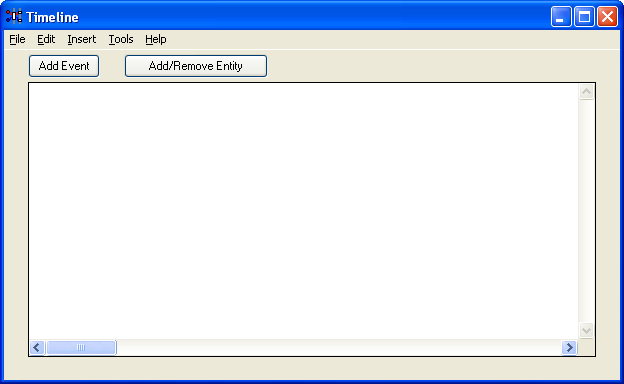
2. Add an Event
To add an event, click the
 Add Event
Add Event button on the main screen of Timeline. If you want to
edit an existing event, right-click on it in the main screen of Timeline and choose
Edit Event. The dialog box shown below will appear. Click on the
Event
tab if it is not currently selected.
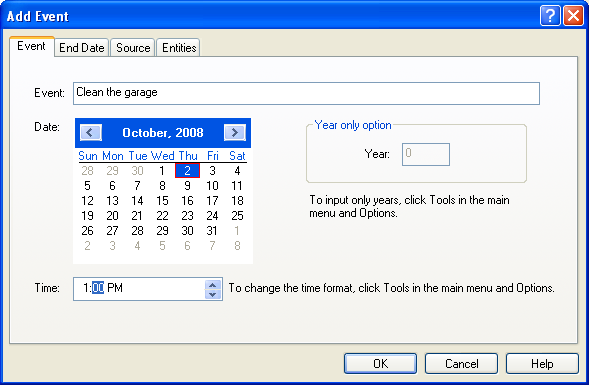
In the box to the right of the word
Event: enter "Clean the
garage." Next, select the date and time. I chose October 2, 2008 and
1:00 PM. Then click the
OK button.
3. Add Another Event
This time click the Event button and enter "Wash the car" with
a date and time of October 9th, 2008 at 1:00 PM.
4. Add a Title
Click Tools in the main menu of the Timeline program, and
Add Title. The dialog box that appears allows you to enter a title for your timeline.
Enter "My Tasks."
5. Saving Your Data
Click
File in the main menu of the Timeline program and Save in the drop-down menu. The
Save As dialog box will appear. You need to save your data so you can import it into RFFlow to create a
timeline. You may also want to edit the data later.
Remember where you saved the file so you can find it again. I named the file
"mytasks."
6. Draw Timeline
Run RFFlow if it is not already running and click
Tools, Auto Charts, and Draw Timeline.
7. Opening the Text File
The timeline data was saved in a .txt file. You have to be able to browse
to the folder where you saved your file
in step 5 and open it. The Open dialog box will appear.
Once you are displaying the correct folder, simply click on the name of the file and click the
Open button.
8. Style of Timeline
You next have to decide what style of timeline you want. I selected Rectangle
and arrow timeline.
9. Unit of Time
For this timeline, I selected Days.
10. Options
Just use all the defaults and click the OK button.
11. Finished
RFFlow automatically draws the timeline shown below. This was just a simple timeline
with two items, but the process is similar for large timelines having hundreds of
events. Now you can save this file in RFFlow. Name it mytasks. It should be
noted that you have created two files. The first was the .txt file named
mytasks.txt. It contains the data you entered. The second file was the RFFlow
file mytasks.flo. It has the graphic display of the timeline. This is a little
confusing to first time users. The data is in one file and the graphics is in
another. The advantage is that you can now customize your timeline in RFFlow as you
would any other chart drawn in RFFlow.
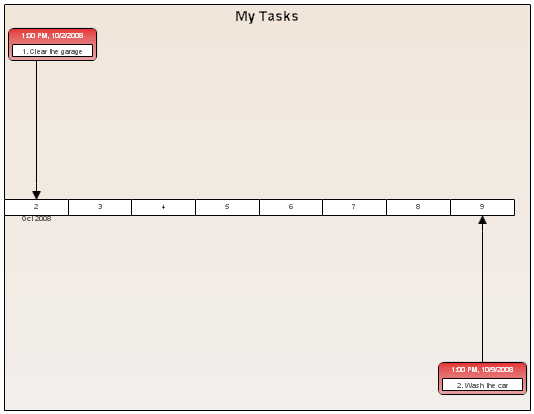
Creating a More Complicated Timeline
RFFlow can automatically draw a timeline based on your data. You can enter
the data or have RFFlow read it from a .csv file. If the data you are using is already in a spreadsheet, then
you should see the Web page How to Draw a
Timeline From a CSV File. The following assumes you will be entering the
data. You may want to print this Web page. If you have not downloaded the free
trial version of RFFlow, you need to do that first.
1. Run Timeline
In RFFlow click
Tools,
Auto Charts, and
Enter Timeline Data.
The Timeline program will run. This feature is included in both the
free
trial version
of RFFlow and the full version. If you are doing a lot of timelines, you will want to
put the timeline buttons on your toolbar. Click
View in the main menu of
RFFlow,
Toolbars, and customize the bottom row of buttons to add the timeline
buttons

and

.
The
Edit Timeline button allows you to enter new timeline data or edit
data you have already entered.
2. Adding or Removing People
If you want to associate a person or group with an event, then you need to first
enter the names of these people. If you don't want people associated with an
event, then you can skip this step.
In a criminal analysis timeline, the people or gangs involved in an
investigation are the entities of that investigation. An entity can also be an
investigative subject, criminal associate, business, person, place, or thing. An
entity can be anything important to an investigation.
For example, if the event is to "Write Financial Report" and Jens
Jensen and Pete Petersen are responsible, you need to enter their names. The
people or groups involved in an event are referred to collectively as entities.
To add entities click the

button. The dialog box shown below will appear.
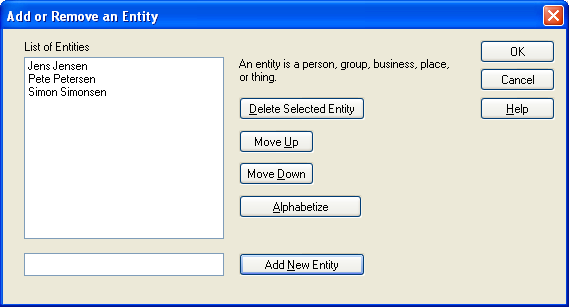
To add an entity, type the name of the entity in the box to the left of the button
Add New Entity and then click the
Add New Entity button. The entity will be added to the list at the top. The entities are arranged in
the order they are added, but you can change the order or put them in alphabetical order.
To move an entity up, click on it and click the
Move Up button. If you want the names sorted by last name, type the last name first, e.g. Washington, George.
To remove an entity, click on the entity in the list of entities to select it. Then click the
Delete Selected Entity button. You can only delete one entity at a time. The only way to edit an entity is to delete it and add it again. When you delete an entity, it will also be removed from any
event to which it is connected.
In the sample above, we added the entities: Jens Jensen, Pete Petersen, and Simon
Simonsen. When you are done adding or removing entities, click the
OK button.
3. Adding an Event
To add an event, click the
 Add Event
Add Event button on the main screen of Timeline. If you want to edit
an existing event, right-click on it in the main screen of Timeline and choose
Edit Event. The dialog box shown below will appear. Click on the
Event
tab if it is not currently selected.
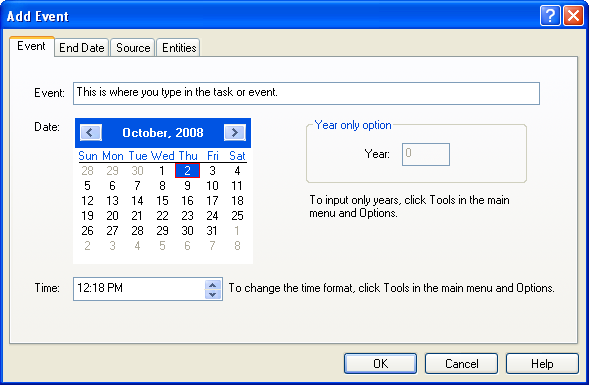
In the box to the right of the word
Event: enter the event. For example, type
"Start writing the financial report." You do not need to number the events.
Next, select the year, month, and day for the event. To change the year,
click on the year and then click the small triangle pointing up or down to increase
or decrease the year. To change the month, click on the triangles pointing left or
right to select earlier or later months. To select the day, click on the day. The current day will be
highlighted.
Next select the time. To change the time, click on the hour, minute, or click AM or PM.
Then click the up or down triangle to increase or decrease the value. For example, if the
hour is 10 and you want 11, click on the 10 and then click once on the triangle pointing up.
If the time says AM and you want PM, click on AM and then click on the triangle pointing up.
Next click the
Entities tab and select the entities that were involved in this event.
Click on each one that took part in this event. You can click on more than one. To remove a selection,
click on the entity again and it will be unselected. Make sure you have
selected everyone associated with the event. If you need to add entities, you have to exit this dialog
by clicking
OK or
Cancel and then click the

button.
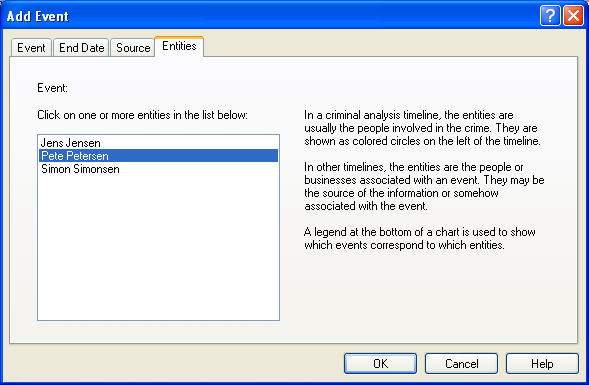
If you want to show an end date for the event, click the
End Date tab.
First put a check in the box next to the words
Include End Date (The end date
of an event is optional) and then you can select a date and time. Criminal
analysis timelines do not use the end date information.

The
Source tab and source information is only used for criminal
analysis timelines. For each event you can list a source. For example, if the
event is "Meeting of two gang members," the source information might
be "Undercover agent verifies meeting in report 7332." In the
actual timeline, the event would be listed as "Meeting of two gang members
(A3)" where the A3 is then connected to a list of all the sources. These
sources are labeled as A1, A2, etc. and can be pasted into your word processor
when the timeline is generated. You then will have a printed list of the sources
which reference each event in the timeline.
When you are done, click the
OK button and this event will be added to the list on the main screen of
the Timeline program. The events are listed chronologically. The list includes the event, date,
time, and entities. To edit an event, right-click on it in the main screen and choose
Edit Event. To delete an event, right-click on it and choose
Delete
Event.
4. Adding a Title
You can add a title and other information to your timeline by clicking Tools
in the main menu of Timeline, and
Add Title. The dialog box that appears allows you to enter a title
for your timeline and to enter case information.
Case information is only used in criminal analysis timelines. The title and case
information will be added to the timeline when it is drawn in RFFlow.
5. Saving Your Data
After entering all the information, you need to save this data to a file on your hard drive. Click
File in the main menu of Timeline and
Save in the drop-down menu. The
Save As dialog box will appear.
You need to save your data so you can import it into RFFlow to create a
timeline. You may also want to edit the data later adding
entities or events.
The folder where your data will be saved is shown to the right of the words
Save
in:.
To save in a different folder, click on the triangle pointing down to the right of the words
Save in: and select a different folder. You can move up a folder by clicking

. Remember where you
saved the file so you can find it again
in step 7 below.
Type the name of the file into the box near the words
File name:. Just type the
file name. The extension .txt will automatically be added. The files used by
Timeline are text files like those created with Microsoft Notepad.
6. Draw the Timeline
After saving the data in a text file, you then import the file into RFFlow. RFFlow creates the
timeline. In RFFlow, click
Tools,
Auto Charts, and
Draw Timeline, or click the
Draw
Timeline 
button.
7. Opening the Text File
The timeline data was saved in a .txt file. You have to be able to browse
to the folder where you saved your file
in step 5 and open it. The
Open dialog box will appear.
The folder whose contents are displayed is listed to the right of the words
Look
in:. To change folders, click on the triangle pointing down and choose a new folder.
You can move up one level in the hierarchy of folders by clicking

.
Once you are displaying the correct folder, simply click on the name of the file and click the
Open button.
8. Selecting a Timeline Style
RFFlow has three different styles of timelines. You can always try one and if
you don't like it, try another one. Larger samples of these timelines are shown
below.
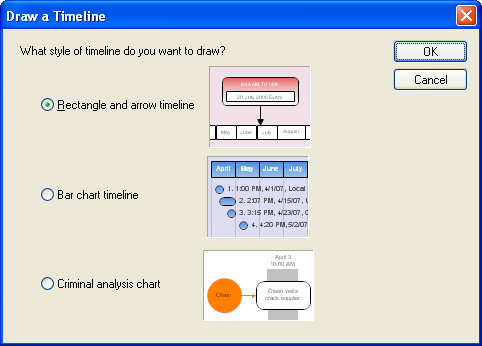
Rectangle and arrow timeline
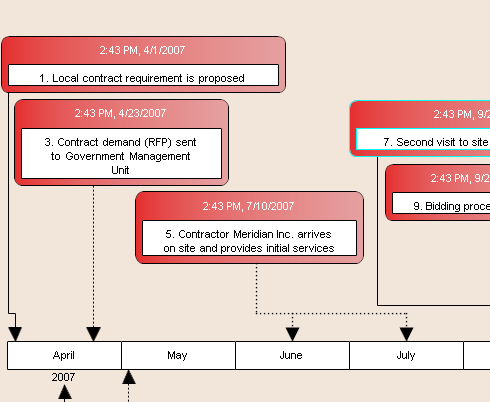
Bar chart timeline
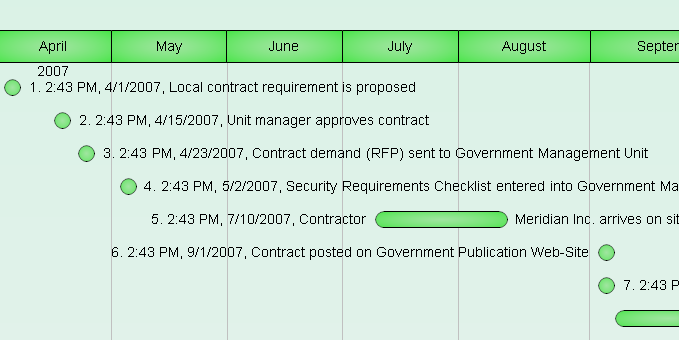
Criminal analysis timeline or event matrix
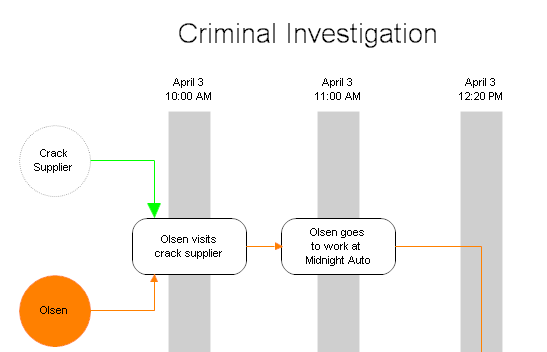
9. Selecting the Unit of Time
Next you select the unit of time you want displayed. This selection has a
big effect on the size of the timeline. If your timeline is too large, select a
larger unit of time.
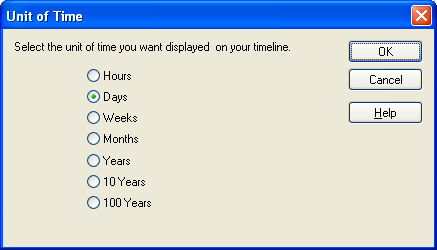
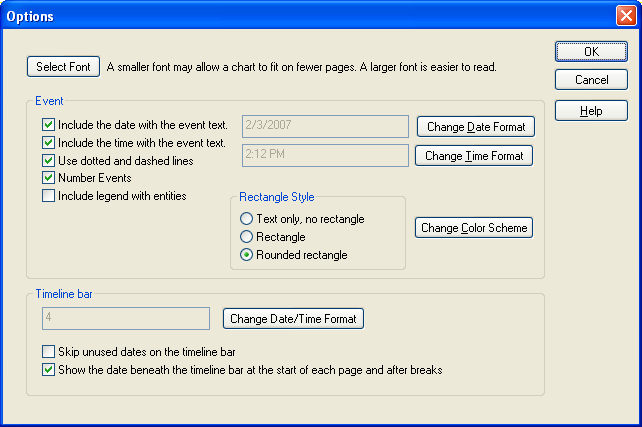
10. Selecting Timeline Options
The Options dialog box is shown above. There are a lot of ways to customize
your timeline. If you are in a hurry, you can always just use the defaults
and click the
OK button.
- Font - You can use the current default font or select a different one. A
smaller font generally results in a smaller timeline.
- Date - You can either show the date with the event text or not show it.
The format of the date can also be changed. You could show dates as 2/3/2008
or as October 3, 2008. You can make your own custom display of the date.
Remember that longer text makes the timeline larger.

- Time - You can either show the time with the event or not show it. If you
show it you can select how it should be shown. You might prefer a 24-hour
clock and show 14:00 instead of 2:00 PM.
- Dotted and Dashed Lines - In the rectangle and line style, it is helpful
to alternate between different line styles to make it easier to follow the
line from the rectangle to the timeline bar.
- Number Events - This is helpful if you have to discuss the timeline in a
meeting. You can then refer to event number so and so.
- Include legend with entities - If you want to show what people are
involved with which events, this should be checked. For example, if the
event is "Write Financial Report" and the person responsible is
Jens Jensen, then the rectangle with "Write Financial Report (B)"
would include a letter and the letter would be listed in the legend as
"(B) Jens Jensen."
- Rectangle style - You can use standard sharp edged rectangles, rounded
rectangles, or no rectangle at all.
- Change Color Scheme - You can select the color of your timeline. These
schemes provide matching colors for the rectangles and background.
- Timeline bar date format - The timeline bar extends across the timeline. One
is shown below. This option allows you to select different date formats.
- Timeline bar - Skip unused dates. For example, assume you are showing days
and the first event is October 2nd and the next is October 5th. You can show
each day or skip days which are not connected to an event.

- In the figure above, the days are numbered 2, 3, etc. The actual date
"Oct 2008" is shown beneath the timeline bar. You can select to
show this date or not.
Criminal Analysis Timeline Options
For a criminal analysis timeline the options are somewhat different and the
dialog box is shown below.
- Change Line Style - You can change the style of the arrow that connects
entities to events.
- Source Information - To include source information, you need to put a
check mark beside Include source information. You can also choose
which letter is used in the source information list. For example, if you
choose the letter "S", then event 3 would read "Meeting of
Southside Gang (S3)" and the source list would be labeled S1, S2,
S3, and so forth. The list of all the sources is copied to the Windows
Clipboard when the timeline is generated and can be pasted into your word
processor.
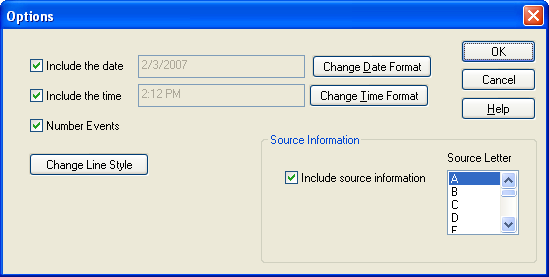
11. Editing the Timeline in RFFlow
Once the timeline is generated, you can edit it like any other RFFlow
chart. If you want to make the title font larger, simply double-click the
title and change the font size. You can add text and lines to highlight parts of
your timeline and move events around. The full editing capability of RFFlow is
available.
12. Finished
At the end of this process, you will have generated two files. One is the text
file (.txt) where you saved the data.
That file was generated by the Timeline program. The other file is the
RFFlow file (.flo) which contains the actual timeline graphics.
Both should be saved as you may want to edit the timeline data and generate another timeline.
13. Other Options of the Timeline Program
If you click on
Tools,
Options in the Timeline program, the
dialog box shown below will be displayed.
- Time Format - When you enter the data, you can use 24-hour time, AM
and PM, or not enter the time at all. This only affects entering the data.
When you draw the timeline in RFFlow, you can change the time format at that
time also.
- Date Format - If you are doing a historical timeline with dates before
the year 1753, then you need to use years only.
- Event and Date Order - This allows you to either list the event
first or the date first on the main screen of the Timeline program. It only
affects that display and not the timeline generated in RFFlow.
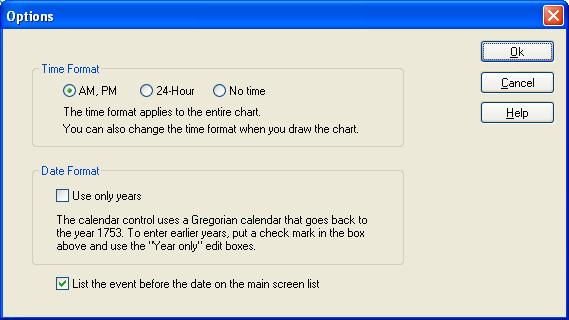
See also:








 The Source tab and source information is only used for criminal
analysis timelines. For each event you can list a source. For example, if the
event is "Meeting of two gang members," the source information might
be "Undercover agent verifies meeting in report 7332." In the
actual timeline, the event would be listed as "Meeting of two gang members
(A3)" where the A3 is then connected to a list of all the sources. These
sources are labeled as A1, A2, etc. and can be pasted into your word processor
when the timeline is generated. You then will have a printed list of the sources
which reference each event in the timeline.
The Source tab and source information is only used for criminal
analysis timelines. For each event you can list a source. For example, if the
event is "Meeting of two gang members," the source information might
be "Undercover agent verifies meeting in report 7332." In the
actual timeline, the event would be listed as "Meeting of two gang members
(A3)" where the A3 is then connected to a list of all the sources. These
sources are labeled as A1, A2, etc. and can be pasted into your word processor
when the timeline is generated. You then will have a printed list of the sources
which reference each event in the timeline.








